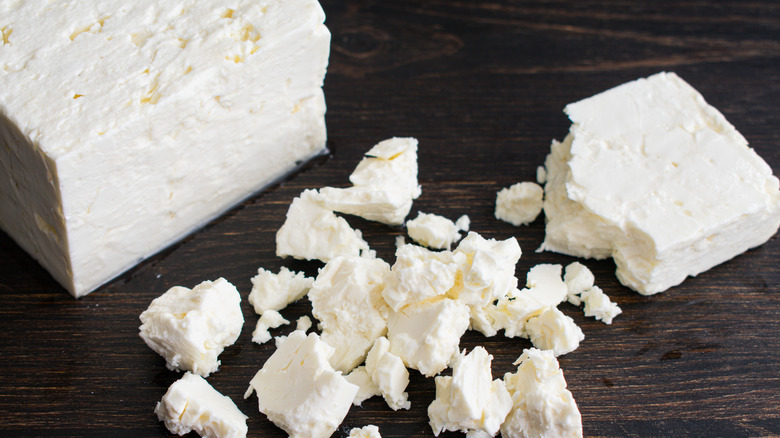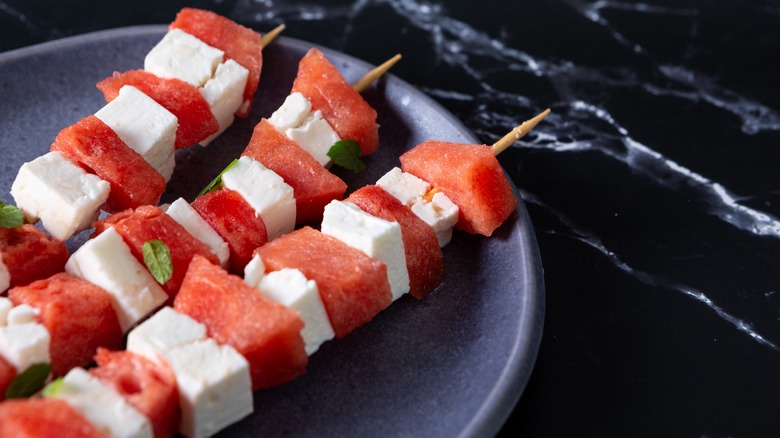Why You Shouldn't Bother With Crumbled Feta, According To José Andrés
We may receive a commission on purchases made from links.
José Andrés tends to focus on his Spanish roots in both his restaurant menus and shared recipes, but his new cookbook follows the Mediterranean coastline into Greece, Turkey, and Lebanon. In the book, titled "Zaytinya" — sharing a name with his restaurant — chef Andrés explores the many varieties of mezze. These are the numerous dishes served in small portions in the Mediterranean region that make up a communal meal. Both on the pages and off, feta cheese makes a big appearance. But for Andrés, he says pre-crumbled feta cheese is not the best option.
Sure, it's easy to reach for those crumbles at the store to save yourself a step when it comes to making a salad or adding feta cheese to the whites of fried eggs. However, you may suffer a big loss when it comes to taste. The whole block offers far more flavor, according to Andrés. How hard is it really to break off a chunk and press it apart anyway? Your tastebuds will definitely thank you for the minimal effort. Plus, pre-crumbled feta tends to include anti-caking additives and can often have an unpleasantly firm and dry texture.
How to buy and store blocks of feta cheese
Feta has protected denomination of origin status (PDO), which means that true varieties can only hail from Greece. However, feta-style cheese can be made all over the world. Because it is so voraciously consumed in Greece, true feta is often challenging to find in other countries — and expensive to purchase. But really, any block packaged in brine will do, but opt for one made with sheep's or goat's milk for a more traditional taste.
This brining preservation technique was used long before modern refrigeration and is a part of block feta today. So, when a block of feta is kept cold and completely submerged, it will stay fresh for up to six months, even after you have opened the package. That is another problem with pre-crumbled feta — once opened, the shelf-life is closer to about a week. Brine also helps the cheese maintain a soft and creamy texture.
Keeping the block in an airtight container covered in salty liquid is key though. If you find you are a little shy on the brine, José Andrés explains that you can make more yourself by simply combining 2 teaspoons of salt with 1 ½-cups of water. Just make sure to use a clean utensil to remove feta from the brine it is stored in to avoid accidentally introducing bacteria.
The best way to use a block of feta cheese
You can use feta from the block anywhere you would use the crumbles. If you are new to feta in this form, the pronounced saltiness, sharp tang, and superior texture may have you hooked. Just think of everything you love about feta, and dial it up a notch.
As such, feta from the block will make dishes where the cheese takes center stage even better, like feta cheese straws with Turkish chili. At his restaurant Zaytinya, Jose Andrés utilizes feta in dishes like a roasted red pepper dip called htipiti and spiced beef meatballs called soutzoukakia. Instead of dry, powdery, and missable, feta crumbles taken from a block of the cheese are both craggy and creamy.
Blocks of feta also open up a whole world of preparations, because you can easily cut it. Use cubes of cheese, ruby-colored watermelon, and fresh mint leaves to make summery skewers. Slices can be breaded and dropped into hot oil to make fried feta BLT sandwiches, too, or to add some vegetarian heft to a non-traditional Greek salad. You can even keep the block whole, and drizzle it with plenty of olive oil and herbs for a showstopping center dish among a bunch of other small plates.



